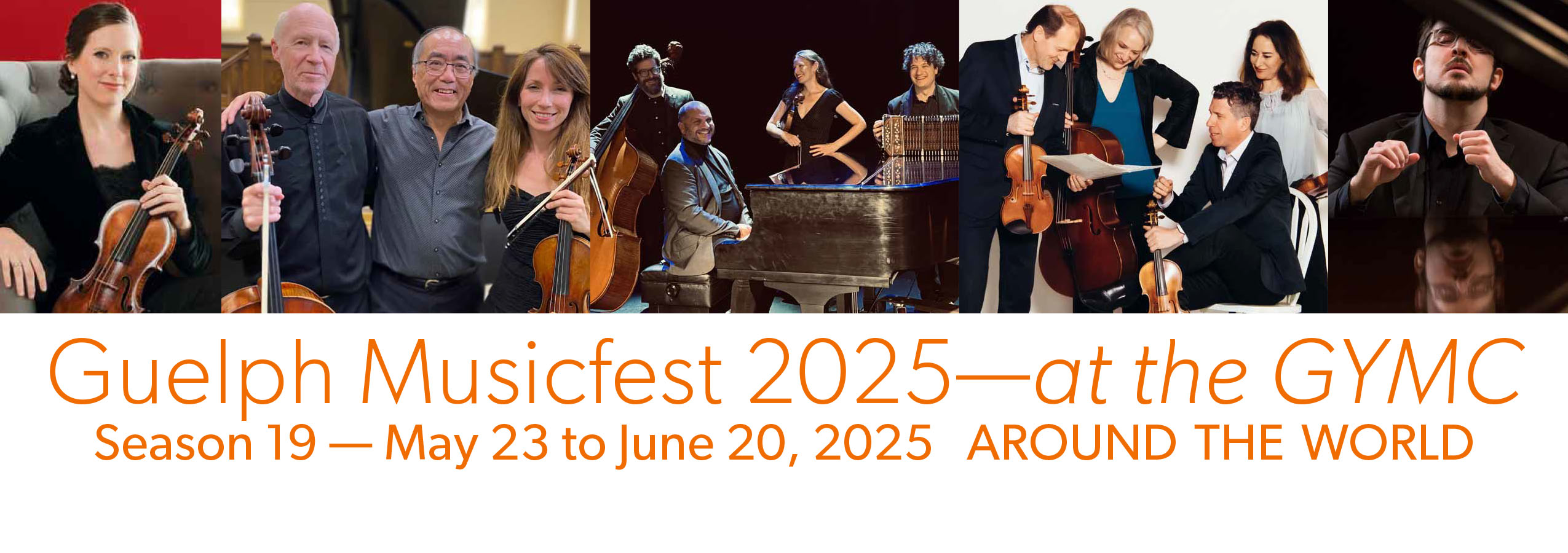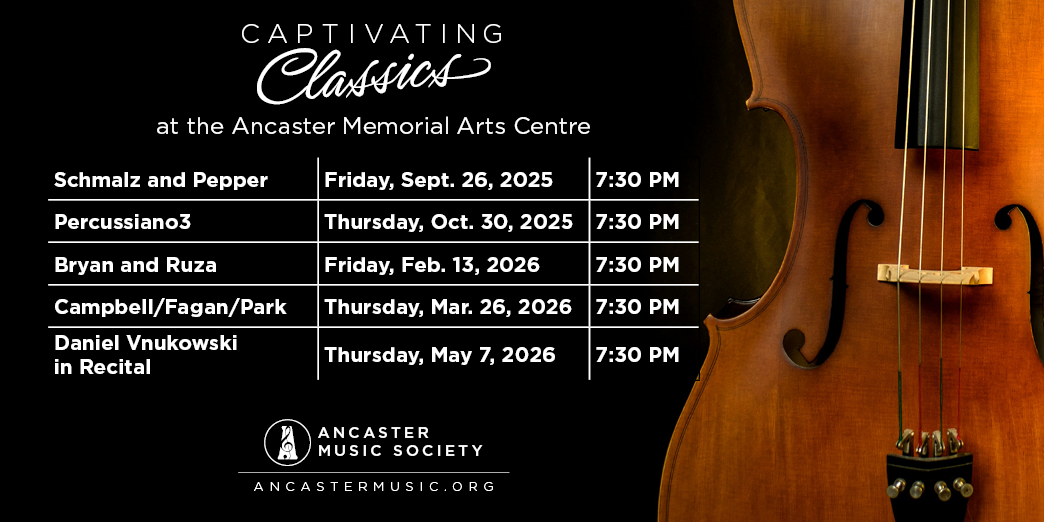November 7 Sadie Fields & Ken Gee
Program notes
This recital unfolds as a tapestry woven from myth, folk memory, song, and contemporary imagination—where the violin and piano reveal their voices in shimmering colour, earthy rhythm, lyrical longing, and bold creativity.
Toru Takemitsu: Distance de Fée (1951)
The concert begins suspended in a liminal world—Takemitsu’s Distance de Fée evokes the delicate magic of a fairy’s touch, dancing between shadow and light. Composed when Takemitsu was just twenty, this piece already bears the hallmarks of his mature style: subtle colour, organic form, and a hushed sense of wonder. Takemitsu’s affinity for French music—especially Debussy—mingles with his Japanese sensibility, shaping a soundscape where violin and piano entwine in phrases that seem to breathe more than sing. The music is rich in octatonic and whole-tone scales, fleeting gestures and floating harmonies; themes recur as if recalled from a half-forgotten dream. Silence is as important as sound, and listeners feel not just melody but space—the “distance” in which a fairy might flutter just beyond reach.
Béla Bartók: Romanian Folk Dances (1915)
The recital’s mood turns earthier and brighter with Bartók’s Romanian Folk Dances—six virtuosic miniatures packed with the life and energy of the Romanian countryside. Bartók, an ethnomusicologist and relentless seeker, collected thousands of folk melodies during his travels. In these dances, he preserves each melody’s original charm, rhythm, and ornamentation, adapting bagpipes, fiddles, and flutes into the language of violin and piano. Every movement speaks in its own dialect: stamping feet in the “Stick Dance,” haunting lyricism in “Pe loc,” exuberant whirling in “Mărunțel.” Bartók’s harmonies are raw, modal, and adventurous—reminding us that folk music, even when filtered through classical technique, remains the voice of the people.
Johannes Brahms: Violin Sonata No. 1 in G major, Op. 78 (“Rain Song”, 1879)
Brahms’ first violin sonata draws us into an introspective landscape glowing with autumnal warmth. Written in a year marked by personal loss, and inspired by his own song “Regenlied” (Rain Song), the sonata is intimate and cyclic, with themes echoing from one movement to the next. The partnership between violin and piano is seamless—dialogue rather than accompaniment—woven with longing and sweet restraint. Brahms builds the music from gentle phrases, with the “rain song” motif carrying a sense of nostalgia and renewal. The first movement is gently flowing, the second alternates storm and calm, and the finale brings back earlier themes in a final, heartfelt reconciliation. Brahms’ mastery lies in making every phrase speak with quiet eloquence, revealing the emotional core of chamber music.
Mieczysław Weinberg: Two Songs without Words
Weinberg’s Two Songs without Words offer a moment of reflection—music composed in the shadow of war and loss, yet full of lyricism and intimacy. Weinberg was a close friend of Shostakovich and a Jewish exile in Soviet Russia; these short pieces distill the essence of song, wordless but pregnant with feeling. The first piece sighs with gentle regret, shaped by Slavic melody and subtle chromaticism; the second murmurs with hope and longing, drawing the listener into private reverie. In Weinberg’s music, solace and sorrow share the foreground, reminding us of music’s ability to comfort when words fail.
Imant Raminsh: Aria (1987)
Raminsh, a Latvian-Canadian composer best known for luminous choral music, brings vocal elegance to the violin with his Aria. The melody is long-breathed, sustained, and almost operatic—violin and piano blend in a song of serene beauty, the kind that stretches time and invites contemplation. Harmonies glow under the melody, supporting lyrical flights and moments of gentle repose. Raminsh’s writing is direct but profound: here, simplicity is a virtue, and the music’s humanity shines through every phrase.
Edward Enman: Imagined Shapes (2022, arranged for violin by the composer for Sadie)
The program closes with Edward Enman’s Imagined Shapes, a celebration of contemporary creativity and musical transformation. Enman, a Canadian pianist and composer, reshapes the work for violin, capturing the spirit of invention that animates new music. The composition explores evolving textures, shifting patterns, and rapid exchanges between the violin and piano. “Imagined Shapes” invites performers and listeners alike to traverse landscapes of possibility, translating emotion and idea into constantly changing form. The music is playful and searching, as if it reimagines familiar chamber music for the present day.
As listeners travel through Takemitsu’s fairy mist, Bartók’s dance-filled villages, Brahms’ rain-soaked nostalgia, Weinberg’s private songs, Raminsh’s lyrical aria, and Enman’s playful shapes, the violin and piano reveal their many selves: mysterious, earthy, passionate, comforting, and adventurous. Each piece is a window into a different world, united by the power of music to inspire, illuminate, and transform.
Toru Takemitsu: Distance de Fée (1951)
The concert begins suspended in a liminal world—Takemitsu’s Distance de Fée evokes the delicate magic of a fairy’s touch, dancing between shadow and light. Composed when Takemitsu was just twenty, this piece already bears the hallmarks of his mature style: subtle colour, organic form, and a hushed sense of wonder. Takemitsu’s affinity for French music—especially Debussy—mingles with his Japanese sensibility, shaping a soundscape where violin and piano entwine in phrases that seem to breathe more than sing. The music is rich in octatonic and whole-tone scales, fleeting gestures and floating harmonies; themes recur as if recalled from a half-forgotten dream. Silence is as important as sound, and listeners feel not just melody but space—the “distance” in which a fairy might flutter just beyond reach.
Béla Bartók: Romanian Folk Dances (1915)
The recital’s mood turns earthier and brighter with Bartók’s Romanian Folk Dances—six virtuosic miniatures packed with the life and energy of the Romanian countryside. Bartók, an ethnomusicologist and relentless seeker, collected thousands of folk melodies during his travels. In these dances, he preserves each melody’s original charm, rhythm, and ornamentation, adapting bagpipes, fiddles, and flutes into the language of violin and piano. Every movement speaks in its own dialect: stamping feet in the “Stick Dance,” haunting lyricism in “Pe loc,” exuberant whirling in “Mărunțel.” Bartók’s harmonies are raw, modal, and adventurous—reminding us that folk music, even when filtered through classical technique, remains the voice of the people.
Johannes Brahms: Violin Sonata No. 1 in G major, Op. 78 (“Rain Song”, 1879)
Brahms’ first violin sonata draws us into an introspective landscape glowing with autumnal warmth. Written in a year marked by personal loss, and inspired by his own song “Regenlied” (Rain Song), the sonata is intimate and cyclic, with themes echoing from one movement to the next. The partnership between violin and piano is seamless—dialogue rather than accompaniment—woven with longing and sweet restraint. Brahms builds the music from gentle phrases, with the “rain song” motif carrying a sense of nostalgia and renewal. The first movement is gently flowing, the second alternates storm and calm, and the finale brings back earlier themes in a final, heartfelt reconciliation. Brahms’ mastery lies in making every phrase speak with quiet eloquence, revealing the emotional core of chamber music.
Mieczysław Weinberg: Two Songs without Words
Weinberg’s Two Songs without Words offer a moment of reflection—music composed in the shadow of war and loss, yet full of lyricism and intimacy. Weinberg was a close friend of Shostakovich and a Jewish exile in Soviet Russia; these short pieces distill the essence of song, wordless but pregnant with feeling. The first piece sighs with gentle regret, shaped by Slavic melody and subtle chromaticism; the second murmurs with hope and longing, drawing the listener into private reverie. In Weinberg’s music, solace and sorrow share the foreground, reminding us of music’s ability to comfort when words fail.
Imant Raminsh: Aria (1987)
Raminsh, a Latvian-Canadian composer best known for luminous choral music, brings vocal elegance to the violin with his Aria. The melody is long-breathed, sustained, and almost operatic—violin and piano blend in a song of serene beauty, the kind that stretches time and invites contemplation. Harmonies glow under the melody, supporting lyrical flights and moments of gentle repose. Raminsh’s writing is direct but profound: here, simplicity is a virtue, and the music’s humanity shines through every phrase.
Edward Enman: Imagined Shapes (2022, arranged for violin by the composer for Sadie)
The program closes with Edward Enman’s Imagined Shapes, a celebration of contemporary creativity and musical transformation. Enman, a Canadian pianist and composer, reshapes the work for violin, capturing the spirit of invention that animates new music. The composition explores evolving textures, shifting patterns, and rapid exchanges between the violin and piano. “Imagined Shapes” invites performers and listeners alike to traverse landscapes of possibility, translating emotion and idea into constantly changing form. The music is playful and searching, as if it reimagines familiar chamber music for the present day.
As listeners travel through Takemitsu’s fairy mist, Bartók’s dance-filled villages, Brahms’ rain-soaked nostalgia, Weinberg’s private songs, Raminsh’s lyrical aria, and Enman’s playful shapes, the violin and piano reveal their many selves: mysterious, earthy, passionate, comforting, and adventurous. Each piece is a window into a different world, united by the power of music to inspire, illuminate, and transform.
Guelph Musicfest 2025 is grateful for the support of many individual donors.Guelph Musicfest 2025 is grateful for the generous contributions of many individual supporters.
Follow Guelph Musicfest on Facebook for the latest news and promotions


